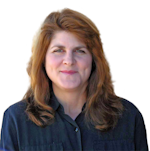Perovskite nanocrystals provide simultaneous illumination and data communication
Researchers at King Abdullah University of Science and Technology (KAUST; Thuwal, Saudi Arabia) have demonstrated that cesium lead bromide perovskite nanocrystals can generate white light that can be used as both an efficient lighting source and for ultrafast data transfer.
RELATED ARTICLE: Perovskite phosphor boosts data rates for visible-light communication
Visible-light communication (VLC)--in which electromagnetic radiation at visible wavelengths (380-700 nm) is used, rather than conventional radio frequency (RF) waves--has recently been proposed as a promising technology for enabling simultaneous energy-efficient illumination and high-speed data communication. Indeed, VLC has several advantages over conventional RF-based communication systems, including high security, fast speed, as well as an unregulated and uncrowded bandwidth.
In a typical VLC system, LEDs or laser diodes (LDs) with phosphors (blue, green, and yellow/red color converters) are used in the transmitters to generate white light for solid-state light (SSL) and data communications. There is, however, a phosphor-associated limitation in the modulation bandwidth of the VLC system. That is, the long excited-state lifetime (the time it takes to re-emit an absorbed photon) of conventional yttrium-aluminum-garnet (YAG)-based phosphors gives rise to a serious bottleneck in VLC applications. This phosphor-associated bandwidth thus limits VLC systems to about 10 MHz and nullifies its key advantages over RF communication systems.
In recent years, perovskites have emerged as 'magic' materials for optoelectronic applications (photovoltaics and photodetectors). Moreover, recent studies have revealed that perovskite nanocrystals (NCs)--in the form of cesium lead bromide--have relatively high photoluminescence quantum yields (PLQYs) and short photoluminescence (PL) lifetimes. In fact, this marriage of high PLQY and short PL lifetime is the essential requirement for ideal SSL and VLC color converters.
Read the rest of the story about these perovskite illuminators and communicators at http://spie.org/newsroom/6756-perovskite-nanocrystals-as-color-converters-for-record-breaking-visible-light-communications.
SOURCE: SPIE Newsroom; http://spie.org/newsroom/6756-perovskite-nanocrystals-as-color-converters-for-record-breaking-visible-light-communications

Gail Overton | Senior Editor (2004-2020)
Gail has more than 30 years of engineering, marketing, product management, and editorial experience in the photonics and optical communications industry. Before joining the staff at Laser Focus World in 2004, she held many product management and product marketing roles in the fiber-optics industry, most notably at Hughes (El Segundo, CA), GTE Labs (Waltham, MA), Corning (Corning, NY), Photon Kinetics (Beaverton, OR), and Newport Corporation (Irvine, CA). During her marketing career, Gail published articles in WDM Solutions and Sensors magazine and traveled internationally to conduct product and sales training. Gail received her BS degree in physics, with an emphasis in optics, from San Diego State University in San Diego, CA in May 1986.
